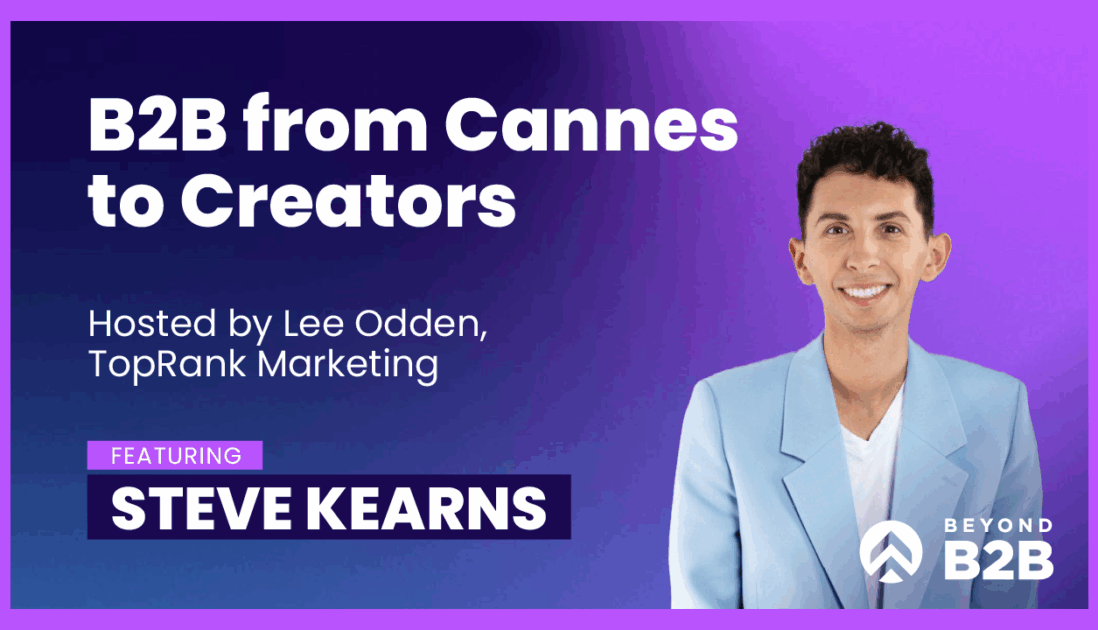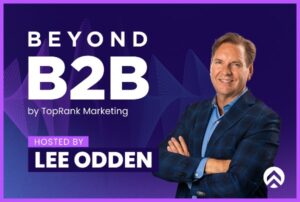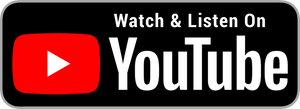In this episode of Beyond B2B Marketing, our CEO Lee Odden talks with Steve Kearns, Global Head of Content for LinkedIn Marketing Solutions to explore how creativity, strategy, and taste are redefining modern B2B marketing. From building the Creative B2B Lions awards at Cannes to launching LinkedIn Studio as a relationship-driven content engine, Steve shares how his team combines emotional storytelling with business outcomes to earn attention and trust. He emphasizes the power of taste-not as superficial style, but as a way to build memorability, aspiration, and brand fame in a world of commoditized content.
Steve also discusses the shifting dynamics of SEO, the rise of B2B creators, and why video is an untapped opportunity for professionals to grow influence. He urges marketers to meet buyers where they search-whether that’s Google, TikTok, Reddit, or ChatGPT-and to embrace both data discipline and human creativity. Steve makes the case for marketers to lead with authenticity, elevate experiences, and invest in thought leadership, especially when most are tempted to automate.
Takeaways:
- Cannes Lions provides a unique platform for B2B recognition.
- LinkedIn’s advertising business has evolved significantly over the years.
- B2B marketing requires a blend of strategy, data, and storytelling.
- Taste and style are crucial in differentiating B2B marketing efforts.
- Successful campaigns often stem from a deep understanding of audience psychology.
- Building relationships through content can lead to stronger demand signals.
- The B2B Marketing Benchmark Report has established LinkedIn as a thought leader.
- Effective marketing combines rational and emotional appeals.
- ServiceNow is building a strong brand identity similar to Salesforce.
- Creating emotional connections with audiences is crucial for B2B brands.
- Thought leadership is more important than ever in today’s market.
- AI is changing the landscape of content creation and marketing budgets.
- Understanding consumer search behavior is essential for effective SEO.
- Video content is becoming increasingly important in B2B marketing.
- Practicing video creation can help overcome initial discomfort.
- Leadership roles come with both accountability and the opportunity for impact.
- Building relationships and a strong team is key to professional growth.
Listen to the full podcast with Steve here:
Watch the interview on YouTube:
Here’s a transcript of our conversation:
Lee: Hello and welcome to the Beyond B2B Marketing podcast. Today we’re talking with Steve Kearns, Global Head of Content for Marketing Solutions at LinkedIn. Great to see you, Steve.
Steve: You too, thanks so much for having me.
Lee: You’ve just returned from Cannes. I’m curious, what were some of the big themes that emerged there?
Steve: I’ve been fortunate to attend Cannes Lions eight or nine times now. The themes that were super pervasive this year were, obviously, AI. You couldn’t go a moment without hearing a talk about AI, how a leader is leveraging it, or how it will transform your organization. There’s a lot of conversation about how AI will transform our craft, from analytics and strategy all the way down to creative production. With that comes both optimism and anxiety. The complementary conversation is about what happens to all the people. If AI automates content creation, what will the people who did that work do with their time? So, there was a lot of talk about the technological revolution we’re in, and the skills revolution that results from it.
Lee: LinkedIn was behind the creative B2B part of Cannes Lions. Can you talk about how that came about?
Steve: When I joined LinkedIn’s advertising business nine years ago, we were a nascent player in the ad space. At Cannes, the big social media platforms dominated the conversation. We were the little engine that could, focused on telling our story, but we didn’t have the resources or market context we have now. Over time, we realized our sweet spot is B2B companies who want to reach the professional audience on our network of over 1.2 billion members. We looked at Cannes and saw a gap: B2B did not have a home there. This was happening as B2B tech companies were booming, so we rode that wave and pushed our B2B positioning.
That led us to partner with the Cannes Lions Festival. We believe great B2B marketing deserves recognition on a global stage, so we worked with the Lions organization to create an awards category specifically for creative B2B work. We’re now in our third or fourth year, and it’s been great to see the work that surfaces. It’s about category leadership; even if the winning work wasn’t executed primarily on LinkedIn, it elevates the entire B2B space, which is our goal.
Lee: Can you explain more about your role and where Marketing Solutions fits in the organization?
Steve: LinkedIn has several revenue streams. Beyond our well-known member platform, we have B2B solutions like LinkedIn Recruiter, Sales Navigator, and Premium subscriptions. Then we have our Marketing Solutions business, which is our advertising arm. Unlike competitors whose businesses are built almost entirely on ads, our model is more diverse.
I joined nine years ago to build the social media program for our ad business. My role grew to oversee all our owned channels and eventually our entire content marketing organization. We’re accountable for three things: first, raising awareness that LinkedIn has a powerful ads business ; second, convincing advertisers to build their brand on our platform over competitors ; and third, providing resources to help our advertisers succeed, which reduces churn. We do all of this through content-our blog, social platforms, web presence, and events. We are the megaphone for the advertising business.
Lee: The combination of strategy, data, and storytelling seems especially valuable right now. How is this timely for B2B marketers who want to excel?
Steve: Generally, people are strong with either data and analytics or with storytelling; the skill sets don’t always naturally cross over. The challenge for B2B marketers is to hone both. The most successful people I see are great storytellers who can translate those stories into meaningful business outcomes. The process starts with a strategic business insight. Then, the creative brain translates that into a compelling campaign. Finally, you must be able to measure its success with metrics.
With more revenue pressure than ever on marketing, this is critical. You can be the greatest storyteller, but if you can’t connect your story to measurable outcomes, you’re screwed. Conversely, if you’re a spreadsheet thinker who can’t get your insights into the hands of customers in a compelling way, you’re also dead in the water. It’s about constantly upleveling both skills.
Lee: You and your team have produced some award-winning work. Is there a campaign you’re most proud of?
Steve: Two come to mind. The first is our B2B Marketing Benchmark Report. The idea was to leverage LinkedIn’s topic authority, data, and brand to become the definitive resource on what’s happening in the minds of B2B marketers. We’re in our third year, and the returns have been incredible. It gives us a foundational thought leadership platform, gets us press, and brings people into our universe.
The second is the LinkedIn Studio we built at Cannes. We set up a broadcast-quality studio at major marketing events to capture content and democratize it for people who can’t attend. It also serves as a way to build relationships. The caliber of leaders we’ve interviewed is unbelievable, and it’s become a huge draw. Now, every January, I get proactive outreach from the teams of top CMOs asking to be in our studio. It’s a powerful signal of demand when you can shift from a “push” to a “pull” mentality.
Lee: What about B2B brands that are killing it on LinkedIn? Any examples?
Steve: I would spotlight ServiceNow. A lot of the talented people who built the iconic “Trailblazer” brand at Salesforce-which was a pinnacle B2B brand that moved beyond features to build an ethos-have moved to ServiceNow. You can see them building that same world there, creating a halo effect around their brand. They understand you need to build emotional structures with your audience, and it’s delivering returns.
Lee: There’s a long-standing brand versus demand debate. What’s your take on full-funnel marketing?
Steve: You need to focus on building momentum. In large organizations, great work often happens in pockets that aren’t connected. For example, after a CMO visits our studio at Cannes, the obvious follow-up is from sales. But what’s next? Everyone in that CMO’s organization who saw their boss post a video from our studio should then be put into a retargeting workflow with messaging about how our solutions can help them. It’s about connecting every touchpoint to bring people closer to a purchase. Most organizations fall flat on that pull-through, and the more you can foster that connected momentum, the better off you’ll be.
Lee: Is thought leadership as important today as when LinkedIn first started advocating for it?
Steve: It’s absolutely more important today. We’re now seeing an attack on thought leadership, driven by a couple of market dynamics. First, AI makes it easy to create scaled, templatized content, which leads leadership to think they can cut budgets for human-centric content. Second, in the current economic environment, the long-term ROI of thought leadership is hard to quantify, making it an easy budget to cut.
Because of this, you’ll see a majority of the market move toward generic, AI-generated content. The companies that stay the course and continue investing in unique, human, contrarian thought leadership will stand out even more. As the market becomes flooded with sameness, authentic thought leadership will become a more valuable and commoditized differentiator.
Lee: What advice do you have for B2B execs who are hesitant to get on camera?
Steve: Practice makes perfect; you just have to get comfortable with the medium. I remember hating the sound of my own voice and feeling cringy watching myself, but you get over it. Consumer behavior has already shifted to video-it’s the TikTok and Instagram era. So the question is, how do you create for that medium? My advice is to just get started. I think we are in the ground-floor era for short-form professional video. There’s a saturation of consumer creators, but not on the B2B side, which presents a huge opportunity for those who get in now.
Lee: You’re in a high-profile, high-pressure job. What keeps you motivated?
Steve: It’s the ability to have an outsized impact. I feel fortunate that I get to solve problems for an organization that I believe provides a net positive service to the world. It’s also the opportunity to influence the outcomes of others. I’ve partnered with brilliant people who have made me a better professional, and I hope I’ve done the same for them. I want my team to build a portfolio of work they’re proud of that will help them get to whatever is next in their careers. It’s been an incredible journey, and I’m grateful for it.
Lee: Where is the best place for people to connect with you?
Steve: It’s absolutely on LinkedIn. I’m trying to get back into the practice of creating content daily, so feel free to follow and connect with me there.
Lee: Thank you so much for your time and insights, Steve.
Steve: Thank you, Lee. This has been awesome.
To find the Beyond B2B Marketing podcast on your preferred podcast platform, check out the links below.





